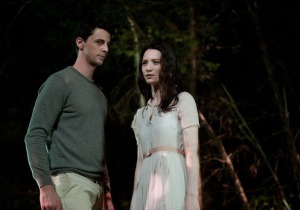Tags
bram stoker, dracula, horror, matthew goode, mia wasikowka, nicole kidman, oldboy, park chan-wook, stoker, wentworth miller
“American Gothic”
Grade: C+/B- (RENT IT)
A SURPLUS OF style, a dearth of drama, “Stoker” falls significantly short of its famous name. The namesake of Park Chan-wook’s new film is Abraham “Bram” Stoker who was born in Dublin in 1847 during the Irish potato famine. He wouldn’t become a master of horror until he published his novel Dracula exactly fifty years later. Stoker hardly invented the vampire legend – Byron’s private doctor, John Polidori, beat him to the punch with The Vampyre, his contribution to the same ghost-telling contest that inspired Mary Shelley’s Frankenstein in 1816. What Stoker did was package a mixture of vampirism and eroticism that Victorians could truly sink their teeth into: an American edition of Dracula followed its English publication, and an abridged edition appeared in 1901.
hardly invented the vampire legend – Byron’s private doctor, John Polidori, beat him to the punch with The Vampyre, his contribution to the same ghost-telling contest that inspired Mary Shelley’s Frankenstein in 1816. What Stoker did was package a mixture of vampirism and eroticism that Victorians could truly sink their teeth into: an American edition of Dracula followed its English publication, and an abridged edition appeared in 1901.
The film “Stoker,” written by actor-screenwriter Wentworth Miller, has all of the goriness of Dracula but it moves more at a zombie’s pace than a real bloodsucker’s. It centers around a melancholic girl named India Stoker (Mia Wasikowska) in what is essentially Hamlet from a daughter’s perspective: India’s father Richard (Dermot Mulroney) has died a  mysterious death upstate and his dashing brother Charlie (Matthew Goode) suddenly appears on the scene where he flirts with his widowed sister-in-law Evelyn Stoker. She’s played by Nicole Kidman, who had long chosen risky roles (“Eyes Wide Shut,” “Birth”), and Wasikowska could be seen as something of her Aussie protégé (“Albert Nobbs,” “The Kids Are All Right”). Over the course of “Stoker,” she has to transform from a shrinking violet into shrieking and violent and it’s a tour-de-force performance inasmuch as she appears practically possessed. “We don’t need to be friends,” India tells her uncle coldly, “We’re family.” At first, it appears as if Uncle Charlie is the evil influence until we sense that India is far from a passive receptor but something truly wicked. She goes from girl to gorgon.
mysterious death upstate and his dashing brother Charlie (Matthew Goode) suddenly appears on the scene where he flirts with his widowed sister-in-law Evelyn Stoker. She’s played by Nicole Kidman, who had long chosen risky roles (“Eyes Wide Shut,” “Birth”), and Wasikowska could be seen as something of her Aussie protégé (“Albert Nobbs,” “The Kids Are All Right”). Over the course of “Stoker,” she has to transform from a shrinking violet into shrieking and violent and it’s a tour-de-force performance inasmuch as she appears practically possessed. “We don’t need to be friends,” India tells her uncle coldly, “We’re family.” At first, it appears as if Uncle Charlie is the evil influence until we sense that India is far from a passive receptor but something truly wicked. She goes from girl to gorgon.
The shower scene in which India masturbates to memories of a recent killing is laughable – stupid even, but Wasikowska never wavers in her eerie embodiment of a girl metamorphosing into something horrible. It’s a bloodbath in every sense of the  word. South Korean director Park is best known for his “vengeance trilogy” (including “Oldboy) and his heavy hand, stylistically speaking, strangles the film, both in terms of timing – the opening credits needlessly hiccup and reset themselves – and storytelling. What exactly is the story of “Stoker” and what relation does it bear at all to vampirism? We live in the age of the vampire (“True Blood,” “Twilight,” “Let Me In,” et al) but Park’s family gothic adds nothing to the lore. It only takes, and in the process, drains your time and your patience.
word. South Korean director Park is best known for his “vengeance trilogy” (including “Oldboy) and his heavy hand, stylistically speaking, strangles the film, both in terms of timing – the opening credits needlessly hiccup and reset themselves – and storytelling. What exactly is the story of “Stoker” and what relation does it bear at all to vampirism? We live in the age of the vampire (“True Blood,” “Twilight,” “Let Me In,” et al) but Park’s family gothic adds nothing to the lore. It only takes, and in the process, drains your time and your patience.



























